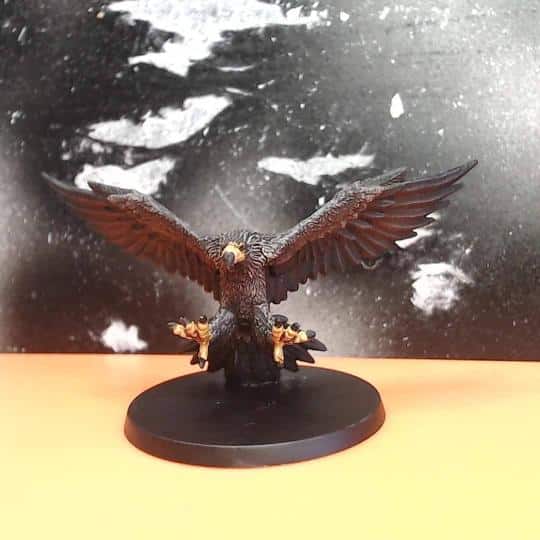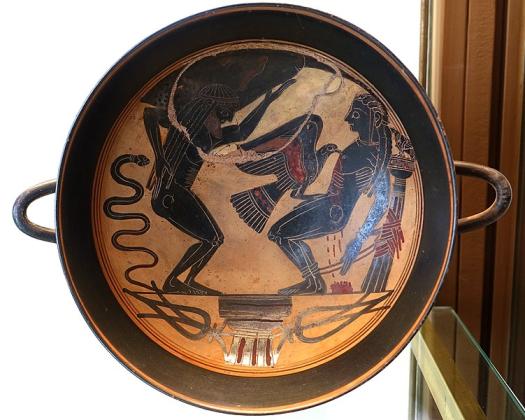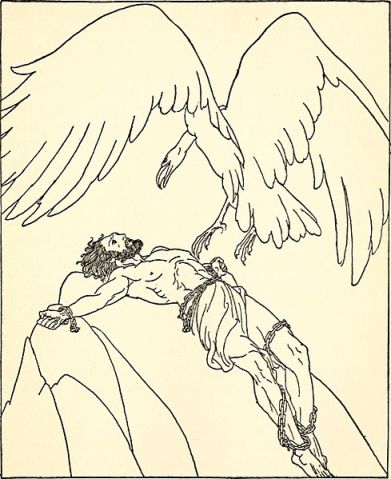The Caucasian Eagle was a giant golden eagle, which Zeus sent to punish the Titan Prometheus for eternity. Every day the Eagle feasted upon its chained victim at the top of the Caucasus Mountain until Heracles, The Strongest Hero came and put an end to this cruel torment.
Key Facts
| Parents | Typhon and Echidna |
| Region | Caucasus Mountain |
| Siblings | Cerberus, Chimera, Colchian Dragon, Crommyonian Sow, Lernaean Hydra, and Orthus |
| Offspring | None |
| Names | Caucasian Eagle |
| Ancient Greek | Αετός Καυκάσιος |
Origins of the Caucasian Eagle

Being one of the children of Typhon and Echidna, the Caucasian Eagle was generally viewed as the fairest among its siblings. It was considered a monster because of its unnatural size and largely of its abhorrent mission of punishing the titan Prometheus every day.
When the Eagle was born, Zeus took it under his protection and raised it at Mount Olympus, making it his sacred symbol of power and authority. The beast received its name from the Caucasus Mountains where it had its nest and from where it was summoned at Zeus’ request.
Impact
The Eagle was Zeus’ revered animal and moreover, his symbol of dominance. The beast that was sent to punish Prometheus reveals the severity of the crime the Titan had committed, as well as the importance Zeus gave to it by sending a magnificent animal to serve justice. Eagles were always thought of as highborn animals; magnificent, but also pitiless. The Caucasian Eagle doesn’t differ much from this common notion, fulfilling its sacred task of punishing Prometheus.
The myth of the Caucasian Eagle
The setting
The inhospitable mountain range of Caucasus seems like the perfect spot for Prometheus’ punishment. The Titan, who cared for the mortals more than the gods did, went against Zeus’ will and gave the gift of fire to humanity. The almighty king of the gods was enraged when he heard of this insolence and had Prometheus chained to a rock at the bleak and depressing heights of Caucasus.
The beast
Zeus decreed that a giant eagle with large wings would come every dawn and mercilessly eat the imprisoned Titan’s liver. However the liver would every night grow back in his body. Thus, the eagle would return the next day and so on. The beast was called the Caucasian Eagle, and it had its nest in close proximity to the exposed prisoner. Prometheus was meant to suffer forever in this violent and sadistic fashion until Heracles climbed the mountain and saved him.
The hero
In order to complete one of his mythic labors (either to find out the location of the Garden of the Hesperides or to kill the fearsome dragon Ladon that guarded the golden apples), Heracles needed information. The only one who could help him with this was Prometheus, but the Titan wanted to be released first before revealing any of his secrets. Heracles then asked his father, Zeus, if he was allowed to free Prometheus from his eternal prison.
Zeus consented for the benefit of his son, and Heracles then traveled to the spot where the Titan was chained. When the Caucasian Eagle appeared in the sky, Heracles fired many of his poison arrows (dipped in Hydra’s blood) at it. The venom was too much for the beast and it soon fell dead on the mountainside.
Depictions
The Caucasian Eagle was a large golden eagle with brown plumage and broad wings. Its eyes were black as a starless night and its high-pitched cry could be heard from a great distance. Its beak and talons were bright yellow and very sharp.
Roles and Responsibilities
The only task of the Caucasian Eagle was to peck and feed every day on Prometheus’ liver. Moreover there are no other known roles or responsibilities the Eagle may have had.
In the old texts

Greek
The Caucasian Eagle appears in Hesiod’s Theogony, in Aeschylus’ tragedy ‘Prometheus Bound’, and Apollodorus’ Bibliotheca, as well as in Apollonius’ Argonautica.
‘When you have spent
a long time underground, you will return
into the light, and Zeus’ winged hound,
his ravenous eagle, will cruelly rip
your mutilated body into shreds
and, like an uninvited banqueter,
will feast upon your liver all day long,
until its chewing turns the organ black.’
Aeschylus’ Prometheus Bound 1263-1270
The beast is also mentioned in Diodorus Siculus’ and Pausanias’ works.
Roman
The Caucasian Eagle is referred to in works by both Hyginus, Propertius, Seneca, and Virgil.
‘Because of this, Mercury, at Jove’s command, bound him (Prometheus) with iron spikes to a cliff on Mount Caucasus, and set an eagle to eat out his heart; as much as it devoured in the day, so much grew again at night. After 30,000 years Hercules killed this eagle and freed Prometheus.’
Hyginus’ Fabulae 144
FAQs
Zeus, the king of the gods, took the Caucasian Eagle when it was still a hatchling, and raised it in his divine abode at Mount Olympus. Like Cerberus was to Hades, so did the Caucasian Eagle was Zeus’ animal, or rather his beast companion. From the tale of Prometheus’ punishment, one can safely assume that the Eagle was blindly loyal to Zeus.
After he was granted permission by Zeus to free Prometheus, Heracles attacked the Caucasian Eagle with his bow. The demigod hero fired many poisonous arrows at the great eagle, thus killing it quickly without having to use his sword or his hands against it.
Featured Image Credit: Francesco Bartolozzi, CC BY 4.0, via Wikimedia Commons

